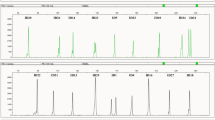Summary
VNTR polymorphisms were investigated for the possible individualisation of human urine samples with reference to doping cases in sport. Investigations were carried out with the RFLP single locus system YNH24/Hinf I and the PCR-VNTR systems Apo B and COL2A1 (AMPFLLs) as well as SE 33 and TC 11 (STRs). Urine samples were tested using 3 different volumes (10 ml, 1 ml and 0.1 ml) after 2 days and 2-5 weeks storage at 4°C. Positive results were obtained for STR systems in all cases and with the smallest volume of urine tested (0.1 ml). The AMPFLP systems gave positive results in 4 out of 8 (Apo B) and 5 out of 8 (COL2A1) samples and YNH24 was successful in 1 out of 3 samples. Negative results were obtained for the AMPFLP systems and YNH24 after longer storage periods whereas the STRs were positive.
Zusammenfassung
Zur Individualisierung menschlicher Urinproben - in Anlehnung an Dopingfälle im Sport - wurden VNTR-DNA-Polymorphismen untersucht. Der Nachweis erfolgte mit dem Single-locus-System YNH24/ Hinf I (RFLP-Technik) and den PCR-VNTR's Apo B und COL2A1 (AMPFLP's) Bowie SE 33 and TC 11 (STR's). 20 Urinproben (3 unterschiedliche Extraktionsvolumina: 10 ml - 1 ml - 0.1 ml) wurden nach (1) 2 Tagen Lagerung and (2) nach 2-5 wöchiger Lagerung bei 4°C typisiert. Die STR-Systeme führten bei 2 Tage alten Urinproben in allen Fällen zu positiven Ergebnissen (minimales Urinvolumen: 0.1 ml), die AMPFLP's in 4 von 8 (Apo B) bzw. 5 von 8 (COL2A1) Fällen; der Nachweis mit YNH24 gelang in 1 von 3 Fällen. Die mehrwöchig gelagerten Urinproben konnten weder mit YNH24 noch mit AMPFLP's typisiert werden. Mit STR's hingegen verliefen auch these Nachweisversuche positiv.
Similar content being viewed by others
References
Allen RC, Graves G, Budowle B (1989) Polymerase chain reaction amplification products separated on rehydratable polyacrylamide gels and stained with silver. BioTechniques 7:736–744
Boerwinkle E, Xiong W, Fourest E, Chan L (1989) Rapid typing of tandemly repeated hypervariable loci by the polymerase chain reaction: application to the apolipoprotein B 3′ hypervariable region. Proc Natl Acad Sci USA 86:212–216
Brinkmann B, Rand S, Wiegand P (1991) Population and family data of RFLP's using selected single- and multi-locus systems. Int J Leg Med 104:81–86
Brinkmann B (1992) The use of STRs in stain analysis. In: Proceedings from the third international symposium on human identification, Promega Corporation, Madison, USA (in press)
Budowle B, Chakraborty R, Giusti AM, Eisenberg AJ, Allen RC (1991) Analysis of the variable number of tandem repeats locus D1S80 by the polymerase chain reaction followed by high resolution polyacrylamide gel electrophoresis. Am J Hum Genet 48:137–144
Edwards A, Civitello A, Hammond HA, Caskey CT (1991) DNA typing and genetic mapping with trimeric and tetrameric tandem repeats. Am J Hum Genet 49:746–756
Nakamura Y, Leppert M, O'Connell P, Roger W, Holm T, Culver M, Martin C, Fujimoto E, Hoff M, Kumlin E, White R (1987) Variable number of tandem repeat (VNTR) markers for human gene mapping. Science 235:1616–1621
Polymeropoulos MH, Rath DS, Xiao H, Merril CR (1992) Tetranucleotide repeat polymorphism at the human beta-actin related pseudogene H-beta-Ac-psi-2 (ACTBP2) Nucleic Acids Res 20(6):1432
Rand S, Wiegand P, Brinkmann B (1992a) Problems associated with the DNA analysis of stains. Int J Leg Med 104:293–297
Rand S, Puers C, Skowasch K, Wiegand P, Budowle B, Brinkmann B (1992b) Population genetics and forensic efficiency data of 4 AMPFLPs. Int J Leg Med 104:329–333
Roewer L, Nürnberg P, Fuhrmann E, Rose M, Prokop O, Epplen JT (1990) Stain analysis using oligonucleotide probes specific for simple repetitive DNA sequences. Forensic Sci Int 47:59–70
Sambrook J, Fritsch EF, Maniatis T (1989) Molecular cloning. A new laboratory manual. Cold Spring Harbour Press, Cold Spring Harbour New York
Wu S, Seino S, Bell GI (1990) Human collagen, type 11, alpha 1, (COL2A1) gene: VNTR polymorphism detected by gene amplification. Nucleic Acids Res 18:3102
Author information
Authors and Affiliations
Rights and permissions
About this article
Cite this article
Brinkmann, B., Rand, S. & Bajanowski, T. Forensic identification of urine samples. Int J Leg Med 105, 59–61 (1992). https://doi.org/10.1007/BF01371242
Issue Date:
DOI: https://doi.org/10.1007/BF01371242




